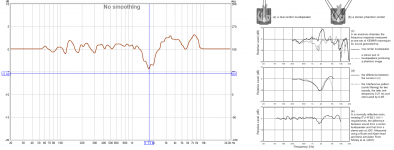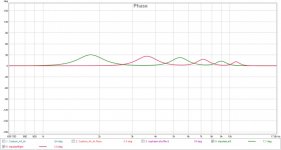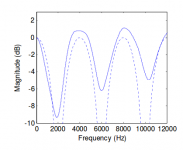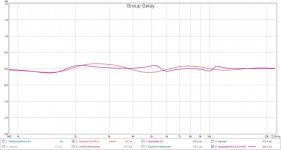Interesting! As I have EQ-cuts at ~3.7 and ~7.3 KHz in my mid channel based on earlier cross talk compensation experiments... Your shuffle is almost completely in line with those cuts now with filling in dips at 1.8, 5.4 and 10.8.
I'd like to hear your reasoning about 3.6 and 7.2 KHz.
We're looking at the same "peaks" obviously - your 3.7 and 7.3, my 3.6 and 7.2. Pretty cool that you found those frequencies by ear!
From experience, I don't think the peaks are crosstalk related - phase shuffling at those 3.6* frequencies had a negative effect. Only the dips are effectively dealt with via phase shuffling.
Having "filled in" the dips perceptually, a broad (low-q) cut of 2-3dB could be used between 2kHz and 10kHz to match the phantom center tone with "real center" HRTF. Two separate problems I think. I would need to look up the difference between center and +- 30 degrees HRTFs. If I find a good EQ setting, I'll incorporate it into the IR.
Pano - yes thats what I'm trying to do. Target the comb filtering for average head at +- 30 degrees speaker spacing. Big thanks for turning me onto this... and to wesayso for prodding to try the filters instead of just debating the theoretical merits!
BYRTT, its surprising how little damaged is incurred once the frequencies are set right. I don't have a linear phase system though. It's not needed to reveal the benefits.
As long as you have two speakers that are amplitude / phase matched, and equidistant from your head at +- 30 degrees (ish), you should be able to experience the effect.
It might make a difference if there's a crossover smack in the middle of the area we are targeting though...
I listened to your 6c, compared to Pano's RePhase Shuffle-2. I picked those two because of the phase angles being the same.
I can't say which one I prefer yet. As the tonal balance changes too between these two I'm often liking the one from Pano. I treated a couple more songs to zoom in on my preference but no luck yet.
It might very well be a tonal difference that I'm picking up, hard to say. I'm just surprised at the effectiveness of that "shot in the dark" from Pano (sorry 😀)
I listened to your 6c, compared to Pano's RePhase Shuffle-2. I picked those two because of the phase angles being the same.
I can't say which one I prefer yet. As the tonal balance changes too between these two I'm often liking the one from Pano. I treated a couple more songs to zoom in on my preference but no luck yet.
It might very well be a tonal difference that I'm picking up, hard to say. I'm just surprised at the effectiveness of that "shot in the dark" from Pano (sorry 😀)
Offline convolution of left channel filter with your left channel correction filter, and right channel impulse with your right channel correction filter will work. Normalization/gain of resultant filters may be necessary.
For import into REW first convert to integer format in Audacity.
This worked for me to combine both my FIR corrections and I could confirm it with REW. Works like a charm. Now listening to the RePhase Shuffler-2 on some more songs... I might try Mike's version next, but I probably need more Re-EQ to fully appreciate that one.
This worked for me to combine both my FIR corrections and I could confirm it with REW. Works like a charm. Now listening to the RePhase Shuffler-2 on some more songs... I might try Mike's version next, but I probably need more Re-EQ to fully appreciate that one.
Great would you share little more details about how you did 🙂
Suggestion to one point phase only correction pretty simple minimal version : ) based on Toole data dynomike shared in post 269, with Q0.5 -/+ 10º phase turn at 1730Hz. Rephase settings file attached below, frq point selected in REW after using FPGraphTracer to read data.
Attachments
Last edited:
Yes of course I'll share... I took the easy way out. I set up a clean zone in JRiver, without any processing active, except the output Format with volume set to 100%. Next I set the output to Disk Writer. I took my current FIR filter into the Cool Edit wave editor and put some extra blank space in front and after the impulse.
Next step I set convolution in JRiver to Pano's Rephase Shuffle2.wav and played back my FIR filter. Opened up the file JRiver wrote to disk and carefully edited the blank space out again. I put that in there because I noticed sometimes the exact file length changes when writing to disk. The intro had the exact length I had set but it was cut a little on the end of the file, so that was good practice. This joined the 2 FIR files perfectly when judged in REW. The phase angles changed exactly as set by Pano's shuffler.
I was thinking of trying something like this:

While I made it I did realize the stereo sum would wiggle a bit in time as I made all phase manipulation above 0 degrees. As I think less time is needed at higher frequencies to manipulate what we hear I made the phase deviation smaller, the higher in frequency I got. I'll try and find some time to listen to it.
I'm afraid your suggested phase shuffle would pull the stage to one side as it isn't shuffling as much as bending the phase sideways. The alternate phase manipulations should avoid that. Phase can really steer the sound besides SPL differences but it might not be a factor at these frequencies.
Next step I set convolution in JRiver to Pano's Rephase Shuffle2.wav and played back my FIR filter. Opened up the file JRiver wrote to disk and carefully edited the blank space out again. I put that in there because I noticed sometimes the exact file length changes when writing to disk. The intro had the exact length I had set but it was cut a little on the end of the file, so that was good practice. This joined the 2 FIR files perfectly when judged in REW. The phase angles changed exactly as set by Pano's shuffler.
I was thinking of trying something like this:
While I made it I did realize the stereo sum would wiggle a bit in time as I made all phase manipulation above 0 degrees. As I think less time is needed at higher frequencies to manipulate what we hear I made the phase deviation smaller, the higher in frequency I got. I'll try and find some time to listen to it.
I'm afraid your suggested phase shuffle would pull the stage to one side as it isn't shuffling as much as bending the phase sideways. The alternate phase manipulations should avoid that. Phase can really steer the sound besides SPL differences but it might not be a factor at these frequencies.
Attachments
Last edited:
It might make a difference if there's a crossover smack in the middle of the area we are targeting though...
I listened to your 6c, compared to Pano's RePhase Shuffle-2. I picked those two because of the phase angles being the same.
I can't say which one I prefer yet. As the tonal balance changes too between these two I'm often liking the one from Pano. I treated a couple more songs to zoom in on my preference but no luck yet.
It might very well be a tonal difference that I'm picking up, hard to say. I'm just surprised at the effectiveness of that "shot in the dark" from Pano (sorry 😀)
My crossover is at 1kHz on the speakers I'm tuning so it shouldn't be a huge issue.
And hey no problem, Pano's rephase-2 shuffler is darn good! I better throw it back in my comparison mix as a "reference".
Clever use of JRiver! I've used the disk writer to modify music files, good thinking to modify the impulse. 
BTW, yes, it was a "shot in the dark", but I could hear the target. 😉

BTW, yes, it was a "shot in the dark", but I could hear the target. 😉
Mike, the more I'm looking at that graph that BYRTT traced, with the tiny examples next to it, the more I'm thinking of only compensating for 1.8 and 10.something...
Leave my EQ cuts at 3.7 and 7.3 (they are not big boosts anyway, 1.4 dB and 1.0 dB respectively) as that 5.4 dip doesn't even dip below the average. I'll compare that one with Pano's shuffle-2.
BYRTT, could you please send me that trace? I'd like to look at the peaks at 3.6 and 7.2. It's very close to what I've found on my own. Maybe I can optimize my cuts a bit.
It's the best shot so far for me, you have excellent hearing 😀...
Leave my EQ cuts at 3.7 and 7.3 (they are not big boosts anyway, 1.4 dB and 1.0 dB respectively) as that 5.4 dip doesn't even dip below the average. I'll compare that one with Pano's shuffle-2.
BYRTT, could you please send me that trace? I'd like to look at the peaks at 3.6 and 7.2. It's very close to what I've found on my own. Maybe I can optimize my cuts a bit.
Clever use of JRiver! I've used the disk writer to modify music files, good thinking to modify the impulse.
BTW, yes, it was a "shot in the dark", but I could hear the target. 😉
It's the best shot so far for me, you have excellent hearing 😀...
The Notches
Going back and looking at the original paper
http://www.sfxmachine.com/docs/FixingThePhantomCenter.pdf
see figure 1 (also attached below)
This shows where the notched will occur in the phantom center for speaker angles of +/- 30 degs. This is probably what I was targeting in my shuffle-2. The notch circa 2K is going to be very noticeable tonally, and the notch at 6K can reduce the quality of consonants in speech. For a stereo spread of 60 degs, those should be the target frequencies. We'd need to calculate the frequencies for other spreads.
How much phase shift is needed? I don't know. I've used +/- 30 degrees because that is what the impulse train gives us, so may be a good starting point. A good bit of testing will be needed to find how much phase shift if enough, at each frequency, to bring the tonal balance into line with a mono source.
Going back and looking at the original paper
http://www.sfxmachine.com/docs/FixingThePhantomCenter.pdf
see figure 1 (also attached below)
This shows where the notched will occur in the phantom center for speaker angles of +/- 30 degs. This is probably what I was targeting in my shuffle-2. The notch circa 2K is going to be very noticeable tonally, and the notch at 6K can reduce the quality of consonants in speech. For a stereo spread of 60 degs, those should be the target frequencies. We'd need to calculate the frequencies for other spreads.
How much phase shift is needed? I don't know. I've used +/- 30 degrees because that is what the impulse train gives us, so may be a good starting point. A good bit of testing will be needed to find how much phase shift if enough, at each frequency, to bring the tonal balance into line with a mono source.
Attachments
Great would you share little more details about how you did 🙂
Suggestion to one point phase only correction pretty simple minimal version : ) based on Toole data dynomike shared in post 269, with Q0.5 -/+ 10º phase turn at 1730Hz. Rephase settings file attached below, frq point selected in REW after using FPGraphTracer to read data.
I did something along these lines, just dealing with the initial dip back at
http://www.diyaudio.com/forums/multi-way/277519-fixing-stereo-phantom-center-28.html#post4693537
These minimal filters I've been posting have substantial advantages over Pano's rephase-2 in terms of center tightness, but also have a greater effect on the perceived center frequency response. YMMV, depends a *lot* on angle to the speakers.
Last edited:
Going back and looking at the original paper
http://www.sfxmachine.com/docs/FixingThePhantomCenter.pdf
see figure 1 (also attached below)
This shows where the notched will occur in the phantom center for speaker angles of +/- 30 degs. This is probably what I was targeting in my shuffle-2. The notch circa 2K is going to be very noticeable tonally, and the notch at 6K can reduce the quality of consonants in speech. For a stereo spread of 60 degs, those should be the target frequencies. We'd need to calculate the frequencies for other spreads.
How much phase shift is needed? I don't know. I've used +/- 30 degrees because that is what the impulse train gives us, so may be a good starting point. A good bit of testing will be needed to find how much phase shift if enough, at each frequency, to bring the tonal balance into line with a mono source.
I have been working off these frequencies for some variations, and they seem a bit less accurate than what's shown in Toole. If you look at the top graph in Toole that compares phantom with real center, you can see there are a couple more dips at around 10k and 14k. I have found adding shuffling up there helps too.
+-45 vs +-30 increases the intensity for sure... surely a balance can be struck, but the method by which we are doing these comparisons is pretty flawed. For best results, should be able to adjust the frequency, q, and phase boost (with symmetrical cut on other channel) in realtime.
These all have quite noticeable shifts in tone as you move front to back.
I noticed BYRTT used a Q of 2 for recreating Pano's shuffler. I was using more aggressive Q's than that until I noticed the actual phase plots. That Q=2 keeps a nice gradual flow, even in the group delay plot. By boosting close by side channels a bit you can make clean flowing deviations. I'm guessing that could also lead to differences in sound perception.
To clarify this look at the differences between Pano's rephrase-2 and Mike's 6C in a group delay plot:

This "might" explain my preference... (one can also see I'm addicted now, I've been playing a lot 😀)
Based on that Toole plot I'm determined to try the 2 shuffles first at ~1.9 and ~10.7
an maybe add one later at what appears to me close to 16/17 KHz.
At first I thought to make the phase deviation smaller for higher frequencies. But there's no logic in that. As the phase will determine the difference in timing and it's already linked to that specific frequency. I'm sticking to 30 degree for now, based on Pano's excellent target shuffler.
Somehow it was more relaxing to listen to than the 6c from Mike. In fact I've spend most of the afternoon listening to all kinds of songs with Pano's shuffler.
To clarify this look at the differences between Pano's rephrase-2 and Mike's 6C in a group delay plot:
This "might" explain my preference... (one can also see I'm addicted now, I've been playing a lot 😀)
Based on that Toole plot I'm determined to try the 2 shuffles first at ~1.9 and ~10.7
an maybe add one later at what appears to me close to 16/17 KHz.
At first I thought to make the phase deviation smaller for higher frequencies. But there's no logic in that. As the phase will determine the difference in timing and it's already linked to that specific frequency. I'm sticking to 30 degree for now, based on Pano's excellent target shuffler.
Somehow it was more relaxing to listen to than the 6c from Mike. In fact I've spend most of the afternoon listening to all kinds of songs with Pano's shuffler.
Attachments
Last edited:
I read the paper that is given as the source for these plots but didn't find much I could use.I have been working off these frequencies for some variations, and they seem a bit less accurate than what's shown in Toole.
How much movement? Moving front to back would change the angle of the speakers, so there should be different nulls, right?These all have quite noticeable shifts in tone as you move front to back.
The idea was to keep the changes gradual. Let us know what you get with a shuffler based more closely on Toole.I noticed BYRTT used a Q of 2 for recreating Pano's shuffler.
I will keep you guys posted, sure... but my son has holidays (a week and a half) so no idea when.
I noticed the gradual movements. My new version, loosely based on Toole's plot and my own previous experiences matches your shuffler quite well, just no shuffling between 3 and 8 KHz for now. I'm just trying to get to listen to what does what. Mike might have a point that we wouldn't want to shuffle at 3.6 and 7.2 KHz. But then again, I might still try it at some point, but with more gradual shifts.
We are all targeting points close to each other. With the RePhase Shuffle-2 I moved side to side and front to back without troubles. It stayed locked in quite well. I also listened way off axis and noticed no ill effects.
I noticed the gradual movements. My new version, loosely based on Toole's plot and my own previous experiences matches your shuffler quite well, just no shuffling between 3 and 8 KHz for now. I'm just trying to get to listen to what does what. Mike might have a point that we wouldn't want to shuffle at 3.6 and 7.2 KHz. But then again, I might still try it at some point, but with more gradual shifts.
We are all targeting points close to each other. With the RePhase Shuffle-2 I moved side to side and front to back without troubles. It stayed locked in quite well. I also listened way off axis and noticed no ill effects.
Thanks!
Looking at Floyd Toole's plots taken from Ben Shirley's work (thank Mike) the difference is mostly at ~2K in a normal room. That sounds about right. You will notice some brightening of the phantom center above 2K, which is interesting and makes me wonder if the shuffler fixes that.
I also have a full plate, but will do some experiments middle of next month. 3 speakers, a dummy head and two measurement mics. I'm curious to see the difference with two mics summed, not just the single ear response. And curious to measure what the different versions of the shuffler do to single and dual ear measurements.
Looking at Floyd Toole's plots taken from Ben Shirley's work (thank Mike) the difference is mostly at ~2K in a normal room. That sounds about right. You will notice some brightening of the phantom center above 2K, which is interesting and makes me wonder if the shuffler fixes that.
I also have a full plate, but will do some experiments middle of next month. 3 speakers, a dummy head and two measurement mics. I'm curious to see the difference with two mics summed, not just the single ear response. And curious to measure what the different versions of the shuffler do to single and dual ear measurements.
.....With the RePhase Shuffle-2 I moved side to side and front to back without troubles. It stayed locked in quite well. I also listened way off axis and noticed no ill effects.
.....Beolab 90 go home 😀
Thanks!
Looking at Floyd Toole's plots taken from Ben Shirley's work (thank Mike) the difference is mostly at ~2K in a normal room. That sounds about right. You will notice some brightening of the phantom center above 2K, which is interesting and makes me wonder if the shuffler fixes that.
I also have a full plate, but will do some experiments middle of next month. 3 speakers, a dummy head and two measurement mics. I'm curious to see the difference with two mics summed, not just the single ear response. And curious to measure what the different versions of the shuffler do to single and dual ear measurements.
Sounds like just the setup we've been waiting for! I don't think summing the two mics has psychoacoustic merit though?
I am also now thinking that the sharper adjustments in phase are worse, like wesayso observed and rationalized via the group delay plots. Also agree that it doesn't make sense to use less phase shift for the higher frequencies. Also, I tried a filter closely matching the frequencies and magnitude of the dips in the reflective room graph, but it sounded really bad. Probably due to the high-q again.
I made a smooth version that targets the dips and it is sounding good. Will post comparison files / comparison webapp so that more people can hear the differences.
For now here is the latest and greatest filter... +- 45 at 2k,6k,10k,15k (roughly).
Sorry for filling the thread with IRs, but I learned something from each one and hope others did too.
Attachments
Don't be sorry Mike, I appreciate it as a learning experience! I really think we are getting somewhere here and it's worth it to post the steps along the way.
This new one looks close to Pano's except for one less rotation, right? And the 45 degree shift of coarse. What Q did you use? This one looks smoother with less group delay even though the shift angle is bigger.
Ah, might as well open it in RePhase to take a look 🙂.
This new one looks close to Pano's except for one less rotation, right? And the 45 degree shift of coarse. What Q did you use? This one looks smoother with less group delay even though the shift angle is bigger.
Ah, might as well open it in RePhase to take a look 🙂.
- Home
- Loudspeakers
- Multi-Way
- Fixing the Stereo Phantom Center





